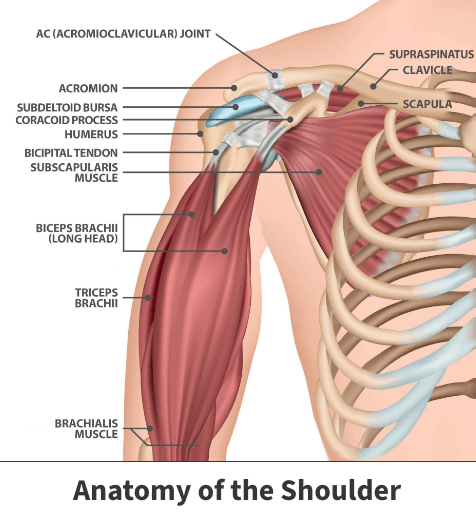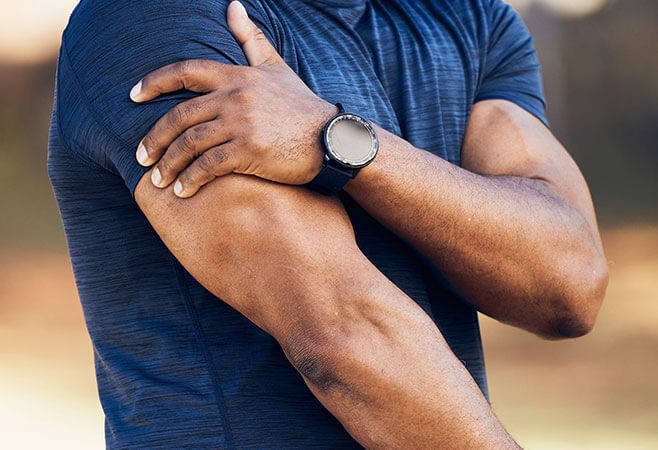AC joint injuries
The shoulder is one of your body’s most important joints. It enables you to lift your arms and perform simple yet often overlooked actions like carrying objects.
Unfortunately, the amount of pressure placed on the shoulder coupled with repeated use often increases its risk of developing damage. As a result, AC (acromioclavicular) joint injuries can arise.
Anatomy

Several bones meet inside the shoulder. The joint, sometimes abbreviated as the AC joint, connects your collarbone and shoulder blade bone, known in scientific terms as the clavicle and scapula.
About
The most common unwanted events impacting the AC joint includes fractures, separations, and arthritis.
Fractures are bone breaks involving the collarbone and shoulder blade.
Separations occur when ligaments (soft tissues bonding your shoulder blade and collarbone) become damaged or torn.
Arthritis occurs when cartilage (the strong, protective material covering bones) gradually becomes damaged or fades. This event heightens the exposed bone’s risk for injury, and several unpleasant symptoms often result.
Causes of AC joint injuries
AC joint injuries can be caused by traumatic events like falls, automobile collisions, and excessive contact received playing sports such as football or wrestling.
Certain injuries can develop and gradually worsen. Cartilage and soft tissue damage often result from age.
Chronic overuse can also be to blame. For example, if you work in a profession or take part in a sport requiring continual heavy shoulder movement, your chances increase. Construction workers, weightlifters, and baseball pitchers are good examples.
Risk factors
Falls bring about a significant number of AC joint injuries. Your risk increases if you participate in the following activities since falls frequently occur in each of these sports.
- Snow skiing
- Water skiing
- Figure skating
- Mountain climbing
Fractures or separations can also limit your shoulder’s range of motion. In the most serious cases, you may not be able to move or lift your shoulder at all.
Symptoms
Specific symptoms and how severe they are depend on the particular type of injury you sustain. Damaged joints might produce any of the following common symptoms:
- Discomfort, especially on the top of your shoulder
- Pain that worsens when you move your shoulder
- The formation of a bump atop your shoulder
- Redness
- Swelling
Fractures or separations can also limit your shoulder’s range of motion. In the most serious cases, you may not be able to move or lift your shoulder at all.
Complications
If you suspect that your shoulder’s AC joint was injured, you are strongly urged to visit your doctor as soon as possible. Failure to quickly diagnose and treat such associated problems can lead to permanent mobility issues and an increased risk for arthritis and fractures.
In certain instances, your shoulder can become deformed. This could impact how you appear and limit your ability to perform even the most basic functions.

Diagnosis
Your doctor will begin a medical evaluation by asking you several questions including what you do for a living and your leisure activities. AC joint injuries are often closely tied to such factors. This information can help your doctor rule out other illnesses or injuries.
In some cases, AC joint injuries can be seen through a simple visual examination of your shoulder. They are typically confirmed using diagnostic imaging devices, like X-rays, magnetic resonance imaging (MRIs), or computerized tomography (CT scans).
Treatment
Treatment will largely depend on the specific problem causing your pain and the severity of that problem.
Separation and fractures are usually placed into categories of severity. Less severe events will need less aggressive treatment and usually will not need surgery. For more severe injuries, you may need surgery.
Nonsurgical treatments
Lower-grade AC joint separations and bone fractures, in addition to mild to moderate cases of arthritis, are usually treated by stopping or limiting activities.
Rest takes the pressure off the joint. Applying ice to the affected shoulder often brings swelling down. Compressing the injured structure with a cast, sling, or thick bandaging protects the joint and prevents it from moving.
Additionally, over-the-counter or prescription pain medications can relieve discomfort.
Surgical treatments
Major separations and fractures may need surgery.
Severe ligament tears will either be repaired or removed and replaced. Completely torn ligaments are often replaced using grafts – soft tissues found in a different part of your body or donated from another individual.
Moderate to severe collarbone or shoulder blade fractures may need to be repaired or repositioned. To complete these procedures, a surgeon may need to place a piece of metal or other material into your bones to help ensure they stay in place long enough for them to heal correctly.
The pain associated with AC joint arthritis can be eased by removing a part of your collarbone. Typically, this operation is a minimally invasive procedure performed arthroscopically.
Treatment, especially following surgical intervention, is likely to include a course of physical therapy. As it is also known, PT is a fitness regimen designed to help your shoulder regain its strength and motion.
The recovery process
If identified and properly addressed, you should recover from an AC joint injury. But it is difficult to pinpoint an exact timeframe. Everyone heals at a different rate, and several important considerations must be made, including:
- Your age
- Your general health
- The specific condition causing the joint injury
- The underlying condition’s severity
Another critical factor is your lifestyle. If you are a competitive athlete, you might choose to undergo more aggressive treatment geared towards restoring your shoulder to compete again at a high level as quickly as possible.
Videos
Related specialties
- Atraumatic Shoulder Instability
- Bankart Repair
- Bicep Tenodesis
- Broken Collarbone
- Bursitis of the Shoulder (Subacromial Bursitis)
- Calcific Tendinitis of the Shoulder
- Clavicle Fractures
- Dislocated Shoulder
- Fractures of the Shoulder Blade (Scapula)
- Glenoid Labrum Tear
- Impingement Syndrome of the Shoulder
- Little League Shoulder
- Reverse Total Shoulder Replacement
- Rheumatoid Arthritis (RA) of the Shoulder
- Rotator Cuff Tears
- Shoulder Arthritis
- Shoulder Arthroscopy
- Shoulder Injury: Pain in the Overhead Athlete
- Shoulder Replacement
- Shoulder Separations
- Shoulder Socket Fracture (Glenoid Fracture)
- SLAP Tears & Repairs
- Subacromial Decompression
- Trapezius Strain (Muscle Strain Of The Upper Back)
- Traumatic Shoulder Instability
